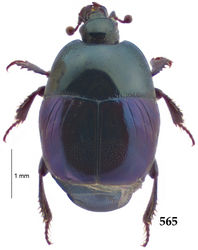| Figures 302–310. 302 Saprinus (Saprinus) amethystinus Lewis, 1900 head, dorsal view 303 antennal club, dorsal view 304 pygidium 305 prosternum 306 mesoventrite 307 lateral disc of metaventrite + metepisternum 308 protibia, dorsal view 309 ditto, ventral view 310 metatibia, dorsal view. |
| Figures 311–319. 311 Saprinus (Saprinus) amethystinus Lewis, 1900 male terminalia: 8th sternite + 8th tergite, ventral view 312 ditto, dorsal view 313 ditto, lateral view 314 male terminalia: 9th + 10th tergites, dorsal view 315 ditto, lateral view 316 male terminalia: spiculum gastrale, ventral view 317 ditto, lateral view 318 male terminalia: aedeagus, dorsal view 319 ditto, lateral view. |
| Figures 321–329. 321 Saprinus (Saprinus) artensis Marseul, 1862 head, dorsal view 322 antennal club, ventral view 323 mentum, ventral view 324 propygidium + pygidium 325 prosternum 326 mesoventrite 327 lateral disc of metaventrite + metepisternum 328 protibia, ventral view 329 mesotibia, ventral view. |
| Figures 330–336. 330 Saprinus (Saprinus) artensis Marseul, 1862 male terminalia: 8th sternite + 8th tergite, ventral view 331 ditto, dorsal view 332 ditto, lateral view 333 male terminalia: 9th + 10th tergites, dorsal view; spiculum gastrale, ventral view 334 9th + 10th tergites; spiculum gastrale, lateral view 335 male terminalia: aedeagus, dorsal view 336 ditto, lateral view. |
| Figures 338–343. 338 Saprinus (Saprinus) australis (Boisduval, 1835) head, dorsal view 339 antennal club, ventral view 340 prosternum 341 mesoventrite 342 lateral disc of metaventrite + metepisternum 343 protibia, dorsal view. |
| Figures 344–352. 344 Saprinus (Saprinus) australis (Boisduval, 1835) male terminalia: 8th sternite + 8th tergite, ventral view 345 ditto, dorsal view 346 ditto, lateral view 347 male terminalia: 9th + 10th tergites, dorsal view 348 ditto, lateral view 349 male terminalia: spiculum gastrale, ventral view 350 ditto, lateral view 351 male terminalia: aedeagus, dorsal view 352 ditto, lateral view. |
| Figures 354–362. 354 Saprinus (Saprinus) chalcites (Illiger, 1807) head, dorsal view 355 antennal club, dorsal view 356 ditto, ventral view 357 mentum, ventral view 358 propygidium + pygidium 359 prosternum 360 lateral disc of metaventrite + metepisternum 361 protibia, dorsal view 362 ditto, ventral view. |
| Figures 363–371. 363 Saprinus (Saprinus) chalcites (Illiger, 1807) male terminalia: 8th sternite + 8th tergite, ventral view 364 ditto, dorsal view 365 ditto, lateral view 366 male terminalia: 9th + 10th tergites, dorsal view 367 ditto, lateral view 368 male terminalia: spiculum gastrale, ventral view 369 ditto, lateral view 370 male terminalia: aedeagus, dorsal view 371 ditto, lateral view. |
| Figures 373–381. 373 Saprinus (Saprinus) chathamensis sp. n. head, dorsal view 374 antennal club, dorsal view 375 mentum, ventral view 376 propygidium + pygidium 377 prosternum 378 mesoventrite 379 lateral disc of metaventrite + metepisternum 380 protibia, dorsal view 381 ditto, ventral view. |
| Figures 382–388. 382 Saprinus (Saprinus) chathamensis sp. n. male terminalia: 8th sternite + 8th tergite, ventral view 383 ditto, dorsal view 384 ditto, lateral view 385 male terminalia: 9th + 10th tergites, dorsal view; spiculum gastrale, ventral view 386 male terminalia: 9th + 10th tergites; spiculum gastrale, lateral view 387 male terminalia: aedeagus, dorsal view 388 ditto, lateral view. |
| Figures 390–398. 390 Saprinus (Saprinus) cupreus Erichson, 1834 head, dorsal view 391 antennal club, dorsal view 392 mentum, ventral view 393 pygidium 394 prosternum 395 lateral disc of metaventrite + metepisternum 396 protibia, dorsal view 397 ditto, ventral view 398 metatibia, ventral view. |
| Figures 399–407. 399 Saprinus (Saprinus) cupreus Erichson, 1834 male terminalia: 8th sternite + 8th tergite, ventral view 400 ditto, dorsal view 401 ditto, lateral view 402 male terminalia: 9th + 10th tergites, dorsal view 403 ditto, lateral view 404 male terminalia: spiculum gastrale, ventral view 405 ditto, lateral view 406 male terminalia: aedeagus, dorsal view 407 ditto, lateral view. |
| Figures 409–414. 409 Saprinus (Saprinus) cyaneus cyaneus (Fabricius, 1775) head, dorsal view 410 prosternum 411 mesoventrite 412 lateral disc of metaventrite + metepisternum 413 protibia, ventral view 414 metatibia, ventral view. |
| Figures 415–421. 415 Saprinus (Saprinus) cyaneus cyaneus (Fabricius, 1775) male terminalia: 8th sternite + 8th tergite, ventral view 416 ditto, dorsal view 417 ditto, lateral view 418 male terminalia: 9th + 10th tergites, dorsal view; spiculum gastrale, ventral view 419 male terminalia: 9th + 10th tergites; spiculum gastrale, lateral view 420 male terminalia: aedeagus, dorsal view 421 ditto, lateral view. |
| Figures 423–431. 423 Saprinus (Saprinus) detritus (Fabricius, 1775) head, dorsal view 424 antennal club, dorsal view 425 mentum, ventral view 426 prosternum 427 mesoventrite 428 lateral disc of metaventrite + metepisternum 429 protibia, dorsal view 430 mesotibia, dorsal view 431 metatibia, dorsal view. |
| Figures 432–438. 432 Saprinus (Saprinus) detritus (Fabricius, 1775) male terminalia: 8th sternite + 8th tergite, ventral view 433 ditto, dorsal view 434 ditto, lateral view 435 male terminalia: 9th + 10th tergites, dorsal view; spiculum gastrale, ventral view 436 male terminalia: 9th + 10th tergites; spiculum gastrale, lateral view 437 male terminalia: aedeagus, dorsal view 438 ditto, lateral view. |
| Figures 440–448. 440 Saprinus (Saprinus) grandiclava Kanaar, 1989 head, dorsal view 441 antennal club, dorsal view 442 ditto, ventral view 443 clypeus + labrum, dorsal view 444 propygidium + pygidium 445 prosternum 446 mesoventrite 447 lateral disc of metaventrite + metepisternum 448 protibia, dorsal view. |
| Figures 449–457. 449 Saprinus (Saprinus) grandiclava Kanaar, 1989 male terminalia: 8th sternite + 8th tergite, ventral view 450 ditto, dorsal view 451 ditto, lateral view 452 male terminalia: 9th + 10th tergites, dorsal view 453 ditto, lateral view 454 male terminalia: spiculum gastrale, ventral view 455 ditto, lateral view 456 male terminalia: aedeagus, dorsal view 457 ditto, lateral view |
| Figures 459–467. 459 Saprinus (Saprinus) laetus Erichson, 1834 head, dorsal view 460 antennal club, ventral view 461 mentum, ventral view 462 propygidium + pygidium 463 prosternum 464 mesoventrite 465 lateral disc of metaventrite + metepisternum 466 protibia, dorsal view 467 mesotibia, ventral view. |
| Figures 468–476. 468 Saprinus (Saprinus) laetus Erichson, 1834 male terminalia: 8th sternite + 8th tergite, ventral view 469 ditto, dorsal view 470 ditto, lateral view 471 male terminalia: 9th + 10th tergites, dorsal view 472 ditto, lateral view 473 male terminalia: spiculum gastrale, ventral view 474 ditto, lateral view 475 male terminalia: aedeagus, dorsal view 476 ditto, lateral view. |
| Figures 478–486. 478 Saprinus (Saprinus) nitiduloides Fairmaire, 1883 head, dorsal view 479 propygidium + pygidium 480 prosternum 481 mesoventrite 482 lateral disc of metaventrite + metepisternum 483 protibia, dorsal view 484 ditto, ventral view 485 mesotibia, dorsal view 486 ditto, ventral view. |
| Figures 487–493. 487 Saprinus (Saprinus) nitiduloides Fairmaire, 1883 male terminalia: 8th sternite + 8th tergite, ventral view 488 ditto, dorsal view 489 ditto, lateral view 490 male terminalia: 9th + 10th tergites, dorsal view; spiculum gastrale, ventral view 491 male terminalia: 9th + 10th tergites; spiculum gastrale, lateral view 492 male terminalia: aedeagus, dorsal view 493 ditto, lateral view. |
| Figures 495–503. 495 Saprinus (Saprinus) pacificus sp. n. head, dorsal view 496 antennal club, dorsal view 497 mentum, ventral view 498 propygidium + pygidium 499 prosternum 500 mesoventrite 501 lateral disc of metaventrite + metepisternum 502 protibia, ventral view 503 mesotibia, dorsal view. |
| Figures 504–510. 504 Saprinus (Saprinus) pacificus sp. n. male terminalia: 8th sternite + 8th tergite, ventral view 505 ditto, dorsal view 506 ditto, lateral view 507 male terminalia: 9th + 10th tergites, dorsal view; spiculum gastrale, ventral view 508 male terminalia: 9th + 10th tergites; spiculum gastrale, lateral view 509 male terminalia: aedeagus, dorsal view 510 ditto, lateral view. |
| Figures 512–520. 512 Saprinus (Saprinus) pseudodetritus sp. n. head, dorsal view 513 antennal club, ventral view 514 mentum, ventral view 515 propygidium + pygidium 516 prosternum 517 mesoventrite 518 lateral disc of metaventrite + metepisternum 519 mesotibia, dorsal view 520 metatibia, dorsal view. |
| Figures 521–527. 521 Saprinus (Saprinus) pseudodetritus sp. n. male terminalia: 8th sternite + 8th tergite, ventral view 522 ditto, dorsal view 523 ditto, lateral view 524 male terminalia: 9th + 10th tergites, dorsal view; spiculum gastrale, ventral view 525 male terminalia: 9th + 10th tergites; spiculum gastrale, lateral view 526 male terminalia: aedeagus, dorsal view 527 ditto, lateral view. |
| Figures 529–537. 529 Saprinus (Saprinus) rarus sp. n. head, dorsal view 530 antennal club, ventral view 531 mentum, ventral view 532 propygidium + pygidium 533 prosternum 534 mesoventrite 535 lateral disc of metaventrite + metepisternum 536 protibia, ventral view 537 metatibia, dorsal view. |
| Figures 538–546. 538 Saprinus (Saprinus) rarus sp. n. male terminalia: 8th sternite + 8th tergite, ventral view 539 ditto, dorsal view 540 male terminalia: spiculum gastrale, ventral view 541 ditto, lateral view 542 male terminalia: 8th sternite + 8th tergite, lateral view 543 male terminalia: 9th + 10th tergite, dorsal view 544 ditto, lateral view 545 male terminalia: aedeagus, dorsal view 546 ditto, lateral view. |
| Figures 548–556. 548 Saprinus (Saprinus) splendens (Paykull, 1811) head, dorsal view 549 antennal club, ventral view 550 propygidium + pygidium 551 prosternum 552 mesoventrite 553 lateral disc of metaventrite + metepisternum 554 protibia, dorsal view 555 mesotibia, ventral view 556 metatibia, ventral view. |
| Figures 557–564. 557 Saprinus (Saprinus) splendens (Paykull, 1811) male terminalia after Ôhara (1994) [4]: 9th + 10th tergites, dorsal view 558 ditto, lateral view 559 male terminalia: 8th sternite + 8th tergite, lateral view 560 male terminalia: spiculum gastrale, ventral view 561 male terminalia: aedeagus, dorsal view 562 ditto, lateral view 563 male terminalia: 8th sternite, ventral view 564 male terminalia: 8th sternite + 8th ventrite, dorsal view. |
| Figures 566–577. 566 Saprinus (Saprinus) tyrrhenus Blackburn, 1903 head, dorsal view 567 antennal club, dorsal view 568 ditto, ventral view 569 propygidium + pygidium 570 prosternum 571 mesoventrite 572 lateral disc of metaventrite + metepisternum 573 protibia, dorsal view 574 ditto, ventral view 575 mesotibia, dorsal view 576 ditto, ventral view 577 metatibia, ventral view. |
| Figures 578–584. 578 Saprinus (Saprinus) tyrrhenus Blackburn, 1903 male terminalia: 8th sternite + 8th tergite, ventral view 579 ditto, dorsal view 580 ditto, lateral view 581 male terminalia: 9th + 10th tergites, dorsal view; spiculum gastrale, ventral view 582 male terminalia: 9th + 10th tergites; spiculum gastrale, lateral view 583 male terminalia: aedeagus, dorsal view 584 ditto, lateral view. |
| Figures 586–594. 586 Saprinus (Saprinus) viridanus Lewis, 1899 head, dorsal view 587 antennal club, ventral view 588 propygidium + pygidium 589 prosternum 590 mesoventrite 591 lateral disc of metaventrite + metepisternum 592 protibia, dorsal view 593 mesotibia, dorsal view 594 metatibia, dorsal view. |
|





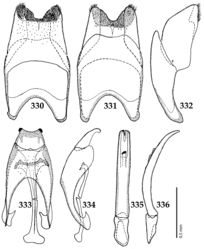


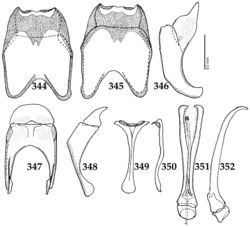







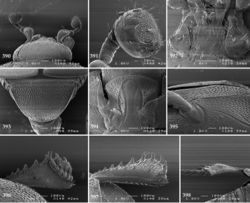





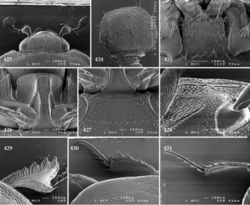


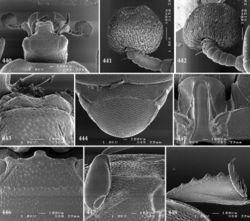







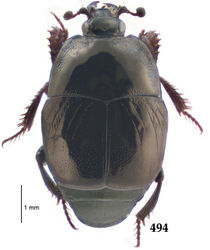



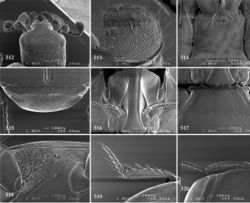


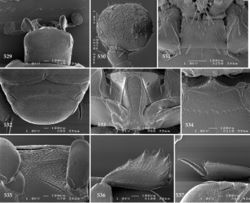

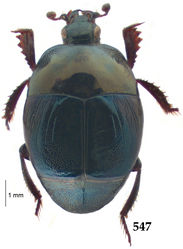

![Figures 557–564. 557 Saprinus (Saprinus) splendens (Paykull, 1811) male terminalia after Ôhara (1994)[4]: 9th + 10th tergites, dorsal view 558 ditto, lateral view 559 male terminalia: 8th sternite + 8th tergite, lateral view 560 male terminalia: spiculum gastrale, ventral view 561 male terminalia: aedeagus, dorsal view 562 ditto, lateral view 563 male terminalia: 8th sternite, ventral view 564 male terminalia: 8th sternite + 8th ventrite, dorsal view.](https://species-id.net/o/thumb.php?f=Zookeys-689-001-g098.jpg&width=157)
